The Shaolin Bench Kung Fu secret book comes with detailed illustrations, and the fighting style is flexible and powerful!
2. Introduction to Southern Shaolin Bench Technique:
Stool, commonly known as "bench" or "long bench", is used as furniture in many towns and villages. As a martial arts equipment, its practice method is spread in towns and villages of southern provinces and cities. In Shaoyang and Loudi areas of Hunan, Nanquan, short stick (eyebrow-high stick), steel knife and bench are called "four treasures of the house". The main footwork of stool art includes horse stance, bow stance, inverted bow stance, kneeling stance, Ding stance, leap (jump) stance and empty stance, etc.; the main techniques of stool art include rushing, smashing, twisting, sweeping (squeezing), blocking (hanging), pressing, dragging, framing, hiding, picking, wrapping the head and wrapping the brain, etc. The routines of Southern Shaolin stool art fully reflect the straightforwardness, strength and technique of Shaolin Kung Fu.
The striking characteristics of this routine are prominent, and at the same time, it embodies the characteristics of Southern Shaolin, which is simple and unadorned, with a stable stance and distinct power methods. Since this routine includes the power methods of Southern Fist, Southern Staff Methods and Sword Methods, it requires practitioners to practice on the basis of Southern Fist, Short Staff and Single Sword.
3. (Southern Style) Bench Score
1. Perform a fist salute; 2. Left and right bow steps to wrap the head and brain with a stool; 3. Ding step to hide the stool; 4. Bow step to charge the stool; 5. Horse stance to smash the stool; 6. Leaping bow step to charge the stool; 7. Left kneeling step to block the stool on the right (left hanging plaque); 8. Right kneeling step to block the stool on the left (right hanging plaque); 9. Upward bow step to pick up and charge the stool; 10. Backward horse stance to hold the stool; 11. Upward left bow step to sweep the stool (left squeeze); 12. Upward right bow step to sweep the stool (right squeeze); 13. Right inverted bow step to twist the stool; 14. Left inverted bow step to twist the stool: 15. Right inverted bow step to charge the stool; 16. Left and right bow steps to wrap the head and brain with a stool; 17. Left inverted bow step to drag the stool; 18. Upward bow step to sweep the stool; 19. Horse stance to press the stool ; 20. 1. Hold the stool with a straight step; 21. Wrap the stool with the head and brain in bow steps to the left and right; 22. Hide the stool with a Ding step; 23. Charge the stool with a bow step; 24. Smash the stool with a horse step; 25. Charge the stool with a leaping bow step; 26. Block the stool with the right by kneeling on the left; 27. Block the stool with the left by kneeling on the right; 28. Pick up the stool with a bow step: 29. Hold the stool with a retreating horse step; 30. Sweep the stool with a left bow step; 31. Sweep the stool with a right bow step; 32. Twist the stool with a right-leaning bow step: 33. Twist the stool with a left-leaning bow step; 34. Charge the stool with a right-leaning bow step; 35. Wrap the stool with the head and brain to the left and right; 36. Drag the stool with a left-leaning bow step: 37. Sweep the stool with a bow step; 38. Press the stool with a horse step; 39. Hold the stool with parallel steps; 40. End the posture.
4. Decomposition action description:
1. Perform the fist salute: Place a stool in front of the practitioner. The practitioner stands upright with his feet together and looks forward (Figure 1), then steps forward and sits on the stool, performing the fist salute with his left palm and right fist (Figure 2).
2. Left and right bow step with head wrapped stool: According to the above posture, stand up and hold the stool with both hands (Figure 3), turn left to the left bow step, and sweep the stool out from the left side of the body with head wrapped around the head (Figure 4, Figure 4 front), then turn right to the right bow step with head wrapped stool (Figure 5). Look forward and slightly downward.
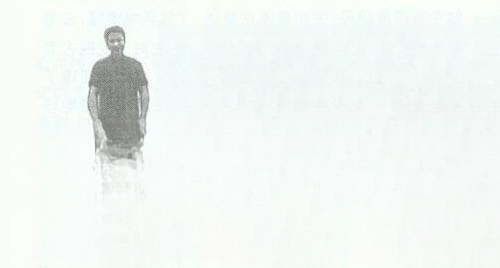
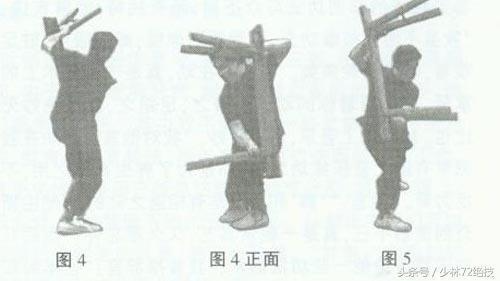
3. Dingbu Hiding Stool: Pull back the left foot to form a left Dingbu, bend the right knee and squat, place the stool upright on the right side of the body with both hands, and look forward (Figure 6).
4. Lunge to rush to the bench: Take a left lunge and rush to the bench diagonally with both hands, with the force reaching the left top of the bench (Figure 7).
5. Horse Stance Smashing the Stool: step forward with the right foot, turn left into a horse stance, circle the stool clockwise, then smash the stool down, making a loud sound on the ground, and look downward (Figure 8, Figure 8 front view).
6. Leap and lunge to rush at the stool: lift the stool with both hands and leap forward (Figure 9). After falling, lunge to the right to rush at the stool (Figure 10, front view of Figure 10), with the force reaching the top of the stool.

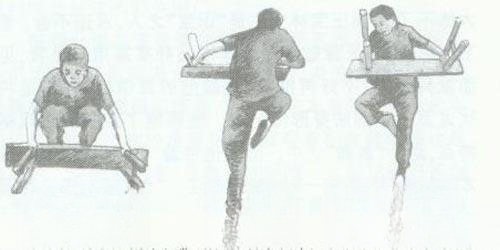
7. Kneeling on the left and blocking the stool with the right (hanging plaque on the left): step back with the right foot, open it horizontally, kneel on the left and block the stool with the right (Figure 11), with the force reaching the stool on the same side.
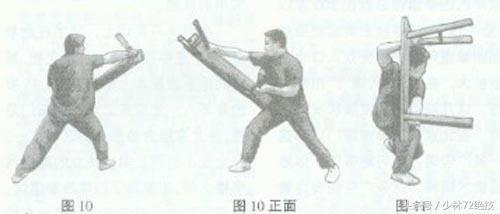
8. Right kneeling step and blocking the stool with the left (right hanging plaque): Immediately follow the previous movement, withdraw the left foot, turn left, kneel down with the right leg into a right kneeling step, at the same time rotate both hands 90 degrees counterclockwise, hold the stool with both hands and block the stool to the left side of the body (Figure 12).
9. Lunge and punch the stool: stand up, lift your left foot and step sideways to the stool, turn the stool clockwise, put your left foot down to the left lunge and punch the stool diagonally. The movements should be continuous and done in one go (Figure 13).
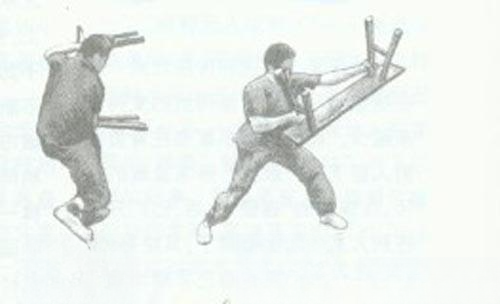
10. Step back to horse stance and place a stool: Step back with the left foot to horse stance, lift a stool with both hands and place it on the stool, exert inch power, and look upwards (Figure 14).
11. Stand in left bow stance and sweep the stool (left squeeze): Stand in left bow stance and sweep the stool with ribs flat, forming a side squeeze (Figure 15).
12. Move up in a right lunge and sweep the stool (right squeeze): without stopping the upward movement, move up in a right lunge and sweep the stool with your ribs flat, forming a sideways squeezing posture (Figure 16).
13. Right Inverted Bow Stance and Twist Bench: withdraw the right foot and the bench will twist back to the right side with the body (Figure 17). Twisting means turning around the body, alternating front and back, so that the left and right sides complement each other.
14. Left Inverted Bow Stance and Twisted Bench: Immediately following the previous movement, withdraw the left foot and twist the bench with the left side of the body (Figure 18). The two movements must be connected.
15. Right Inverted Lunge to Punch the Bench: Immediately following the previous movement, turn right side into a right inverted lunge, and punch the bench when you reach the right side behind your back (Figure 19).
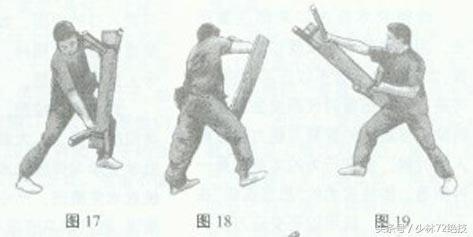
16. Left and right head-wrapped stool: This posture is similar to action 2. The previous posture is a fixed step, and the left and right changes. The direction of this posture is forward and backward, and this action is one step and one movement. First turn left, step up and stand on the stool with the right foot, left up and right down (Figure 20), then continue to turn to the left side, and wrap the stool at the same time, change to left down and right up (Figure 21, Figure 22), then withdraw the left foot and swing the stool with the left inverted bow step, change to left up and right down (Figure 23), this is the head-wrapped stool, the same as the head-wrapped method of method 1. Keep moving up, then turn right and stand on the left foot and wrap the stool with the head, change to right up and left down (Figure 24), continue to turn right, change to left up and right down (Figure 25), then withdraw the right foot and swing the stool with the right inverted bow step, change to right up and left down (Figure 26), this is the brain-wrapped stool, the same as the brain-wrapped method of the knife method. This stool method is to rotate one circle counterclockwise (head wrapping method), and then rotate one circle clockwise (brain wrapping method). The body and the stool are united to protect the body, so that the stool forms two circles.
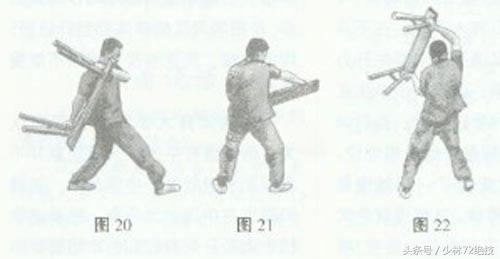
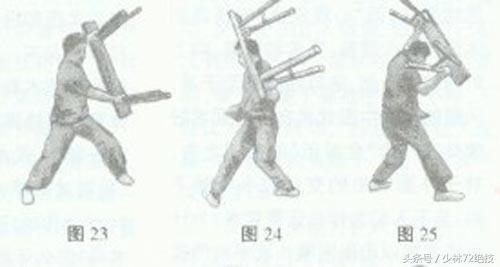
17. Left Inverted Lunge and Stool Dragging: Move the center of gravity backwards to form a left inverted lunge. The stool will move with the momentum into a stool dragging posture, with the strength contained in the stool body (Figure 27).
18. Bow Step and Sweep the Stool: Without stopping the previous movement, the right bow step changes from dragging the stool to sweeping the stool, sweeping horizontally from the waist (Figure 28), with force diagonally downward.

19. Horse stance and bench press: Keep moving upwards, turn left and do horse stance and bench press (Figure 29, front view). When practicing, it is from the back, this picture is from the front, and the eyes are looking down to the right.
20. Walking with a Stool: Stand up, hold the stool in front of your chest with both hands, with your right foot solid and your left foot empty. This is a foot-over movement, a flash (Figure 30, front view). When practicing, it is from the back, this picture is from the front.
21. Left and right bow stance to wrap the head and stool - 38. Horse stance to press stool (same as action 2-action 19), but the action is one go and one return, the direction is completely opposite.
39. Holding the Stool with Sided Steps: Continue from the previous posture. After pressing the stool in horse stance , bring the left foot back and bring it together with the right foot, while simultaneously raising both hands to hold the stool horizontally (Figure 31).
40. Closing posture: Following the previous posture, place the stool in front of you with both hands. Then stand upright with both hands in a fist salute (Figure 32). The demonstration is over.
